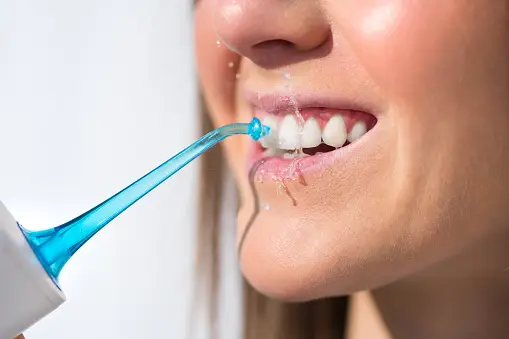Flossing is an activity that involves using a floss to clean in between your teeth and gumline. Flossing helps to remove plaque and food particles stuck there; it reaches spots where the toothbrush cannot reach and promotes overall dental health.
Types Of Floss
Flossing can be done through the use of any of the following: dental floss, floss pick, inter-dental brushes or a water flosser; each having its own benefit and disadvantage
- Dental floss: Dental floss is a thin stringed-like material used for removing plaque and food particles around the teeth and gumline. It requires special application and dexterity by the individual so avoid gum bleeding and because of this, most people avoid it.
- Floss pick: it is a disposable devise made of plastic and string floss. It is safer to use and doesn’t require special application like the dental floss. They come as ‘F’ or ‘Y’ shaped with a rubber handle and a piece of floss between two edges.
- Interdental brushes: This serves as alternative to flossing. Interdental brushes are specially designed with bristle heads to remove plaque and food particles stuck in between the teeth and comes in various width adopted to fit in the spaces between your teeth.
- Water flosser: This is an oral irrigator that uses high-pressured water to remove plaques and food particles in-between the teeth. It is often recommended as an alternative to dental flossing because it is easier to perform and gum bleeding is minimized.

Importance Of Flossing
- Regular flossing helps you avoid tooth ache and decay
- Flossing prevents decalcification of your teeth.
- Regular flossing prevents plaque buildup that cause gingivitis
- Flossing regularly gives you a confident smile.
- It eradicates bad odor since the bacteria from residual food particles that produce foul smell have been removed.
What is Traditional flossing?

Traditional flossing involves the use of dental floss – a thin stringed material – to floss. It has been in existence for years and requires special maneuvering and application. It involves twisting the floss around the fingers and running it gently in-between each tooth.
Process:
- Tear off the required length of floss to be used (18in is recommended)
- Wrap some portion of it around both your middle finger but endeavor to free a little portion that would go through your teeth.
- Use your fingers (Index and thumb) to tightly hold the free section and curve it around the base of each tooth gently sliding in-between them in an up-down fashion.
- Gently pull out and wrap away used portion while sliding in the unused section.
Advantages Of Traditional Flossing
- Traditional flossing is regarded as the most inexpensive; a package of dental floss cost much less than a water flosser device.
- It is also an effective flossing routine because it ensures that plaques, tartar and food particles stuck by the sides and in-between the teeth are reached.
- It also enables you concentrate on stubborn plaques; allows you apply the appropriate pressure; and use the inch of floss comfortable for you.
- It is also highly mobile. You can easily pack them while travelling without taking too much space or causing inconvenience.
Disadvantages Of Traditional Flossing
- Some people find it difficult to maneuver as such they are discouraged from flossing regularly.
- If you do not take care, you may cause your gum to bleed.
- Children and the aged may find it difficult to use.
Nevertheless, the floss pick was adapted to counter these problems. They come in portable and easy to use design for everybody.
Then, What Is Water Flossing?

Water flossing is a recent trend that aims to make flossing seamless and automated. It involves the use of a forceful stream of water to remove plaques and particles in-between the teeth and gum. It is recommended for those who find traditional flossing quite technical or those wearing braces and as such maneuvering the dental floss through the wires may prove tricky.
Water flosser devices come in different shapes and sizes and often require electricity or battery to run. They also have multi-colored tips that enables usage by various individuals. A popular brand of water flosser is the Waterpik.
Advantages of water flosser:
- It is easy to use by all. Flossing is literally done for you; you only need to move the tips between the teeth while the device works.
- Water flossing promotes a healthy gum and avoids gum bleed.
- It has specially adapted tips for cleaning braces and orthodontic devices, plaque removal and treating periodontal pockets.
Disadvantages of water flosser
- It can be messy with water splashes if you do not do it appropriately.
- It costs more than traditional dental floss.
- It isn’t as mobile as traditional flosser. It can take up bag space and may require the use of electricity to power as such discourage regularly flossing when in transit.
Conclusion:
This article’s aim of contrasting traditional and water flossing has been achieved. It is now left for the individual to decide which methods appeals to them. The major aim however is to encourage regular flossing routine, an important activity for dental health.







